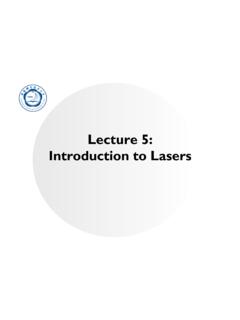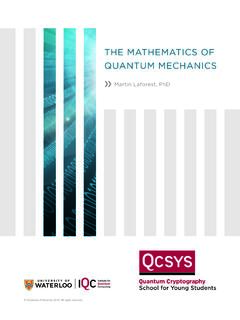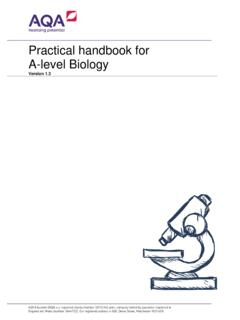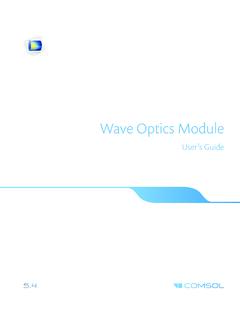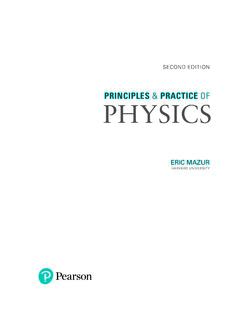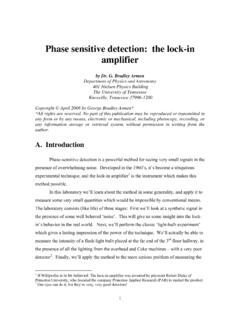Transcription of arXiv:2203.06454v1 [physics.plasm-ph] 12 Mar 2022
1 laser plasma accelerated ultra-intense electron beam for efficiently exciting nuclear isomers Jie Feng,1, 2 YaoJun Li,1, 2 JunHao Tan,1, 2 WenZhao Wang,1, 2 YiFei Li,3 XiaoPeng Zhang,4 Yue Meng,1. XuLei Ge,1, 2 Feng Liu,1, 2 WenChao Yan,1, 2 ChangBo Fu,5 LiMing Chen,1, 2, and Jie Zhang1, 2, 3, . 1. Key Laboratory of laser Plasma (MoE), School of physics and Astronomy, Shanghai Jiao Tong University, Shanghai 200240, China 2. IFSA Collaborative Innovation Center, Shanghai Jiao Tong University, Shanghai 200240, China 3. Laboratory of Optical physics , Institute of physics , Chinese Academy of Sciences, Beijing 100190, China 4.
2 Institute of High Energy physics , Chinese Academy of Sciences, Beijing 100049, China 5. [ ] 12 Mar 2022. Key Laboratory of Nuclear physics and Ion-beam Application (MoE), Institute of Modern physics , Fudan University, Shanghai 200433, China (Dated: March 15, 2022). Utilizing laser plasma wakefield to accelerate ultra-high charge electron beam is critical for many pioneering applications, for example to efficiently produce nuclear isomers with short lifetimes which may be widely used. However, because of the beam loading effect, electron charge in a single plasma bubble is limited in level of hundreds picocoulomb.
3 Here, we experimentally present that a hundred kilo-ampere, twenty nanocoulomb, tens of MeV collimated electron beam is produced from a chain of wakefield acceleration, via a tightly focused intense laser pulse transversely matched in dense plasma. This ultra-intense electron beam ascribes to a novel efficient injection that the nitrogen atom inner shell electrons are ionized and continuously injected into multiple plasma bubbles. This intense electron beam has been utilized to exciting nuclear isomers with an ultra-high peak efficiency of 1015 particles/s via photonuclear reactions. This efficient production method of isomers can be widely used for pumping isotopes with excited state lifetimes down to picosecond, which is benefit for deep understanding nuclear transition mechanisms and stimulating gamma-ray lasers.
4 I. INTRODUCTION electrons can be trapped and accelerated in every wake- field and the beam charge can be increased tremendously to tens of nC[31, 32], but it requires a hundred joule class The laser plasma wakefield accelerators (LWFAs) have picosecond (ps) laser facility. Moreover, directional elec- attracted significant interests in recent years[1 4] due tron beams with tens of nC charge have also been pro- to high acceleration gradients (hundreds of GV/m) and duced via vacuum laser acceleration with a plasma mir- beam current (tens of kilo-ampere), thus not only en- ror injector[33, 34].
5 Unfortunately, the beam collimation able GeV electron accelerators reducing to a length of suffers from the ponderomotive force of the laser pulse in centimeters[5], but drive secondary radiation/particle vacuum during acceleration, which results in a large di- sources with ultra-high brightness/flux[6 8]. In bubble[9] vergence angle ( 20 ) and a hole in the beam profile[35]. or blowout[10] regime LWFAs, an ultra-short intense By way of contrast, a hundred nC collimated ( 3 ) elec- laser pulse excites wakefield in underdense plasma, and tron beam has been acquired from laser solid interactions the laser ponderomotive force expels electrons form- with deliberately induced pre-plasma[36].
6 Although laser ing ion cavities (or called bubbles) in which electrons solid interaction is propitious to realize ultra-high charge, can be accelerated. In the last decade, some break- an important limited factor is the acceleration distance throughs of LWFAs have been achieved such as ultra- resulting in electron energy usually less than 10 MeV. high stability[11], multi-GeV energy[12], femtosecond (fs) Moreover, tens of nC electron beam with higher energy beam duration[13], ultra-low energy spread[7, 14] etc., gain can also be realized in LWFA of near-critical-density but beam charge is limited below hundred picocoulomb plasma[37 39], but the beam divergence angle is usu- (pC).
7 Ally large ( 15 ) due to electrons interaction with laser Recently, several hundred pC electron beams have been fields, and they would also scatter in dense plasma af- observed in the process of double self-injection[15, 16] and ter the laser pulse rapid depletion. In general, for laser self-truncated ionization injection[17 20] respectively, plasma electron acceleration, it is a great challenge to re- but it is still difficult to reach nanocoulomb (nC) due alize electron beam with large charge, tight collimation to the beam loading effect of bubble regime[10, 21, 22]. and high energy at the same time.
8 There are also some efforts in improving beam charge by In this work, the electron beams with charge of 20. increasing laser energy and using high-Z gas[23 26], but nC and small divergence angle 6 have been gener- they still do not break through the limitation of beam ated experimentally from a tens of TW tightly focused loading effect. While self-modulated laser wakefield ac- laser pulse interacting with high density gas. Particle celeration (SM-LWFA)[27 30] that long laser pulse over- in cell simulation shows that a novel and efficient elec- laps with several tens of plasma waves, large number of tron injection scenario of electrons successively ionization 2.
9 Injecting into multiple bubbles has been realized, result- the laser power, , 27 TW, resulting in an intensity ing in super-high charge surpassing the scaling law[40] of of 1019 W/cm2 , corresponding normalized vector LWFA in bubble regime. The electron beams generated potential a0 By regulating the gas back pres- have appropriate energies (10s MeV) for driving photonu- sure, the outflow nitrogen gas density can range from clear reactions and nuclear isomers production. So, these 3 1017 cm 3 to 2 1019 cm 3 . After the laser inter- dense and energetic electron beams hit on Indium target, action with pure nitrogen gas, the accelerated electron and a significant amount of multiple isomers have been beam bombards a 1 mm-thick tungsten (W) converter produced with an ultra-short time duration.
10 This opens which is located at the downstream of nozzle to generate a new path to produce nuclear isomers with an extremely bremsstrahlung radiation. Then the collimated -ray in- high peak efficiency. duces the ( , 0 ) reaction, photofission ( , n), ( , 2n), ( , 3n) reactions, and the followed neutron capture (n, ). reaction in a 3 mm-thick indium (In) converter. These II. EXPERIMENTAL SETUP products of above reactions would be in nuclear isomeric states or become radionuclides, which can be identified The experiment is carried out using a Ti: Sapphire by measuring their characteristic decay radiations with a laser system at the Laboratory of laser Plasmas of high pure germanium detector.
![arXiv:0706.3639v1 [cs.AI] 25 Jun 2007](/cache/preview/4/1/3/9/3/1/4/b/thumb-4139314b93ef86b7b4c2d05ebcc88e46.jpg)

![arXiv:1301.3781v3 [cs.CL] 7 Sep 2013](/cache/preview/4/d/5/0/4/3/4/0/thumb-4d504340120163c0bdf3f4678d8d217f.jpg)
![@google.com arXiv:1609.03499v2 [cs.SD] 19 Sep 2016](/cache/preview/c/3/4/9/4/6/9/b/thumb-c349469b499107d21e221f2ac908f8b2.jpg)






